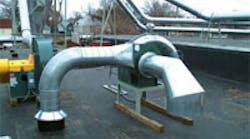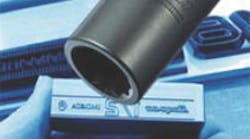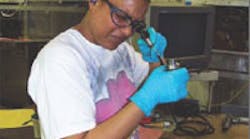Square D Co., Lexington, Ky., a stamping and assembly plant, makes safety switches that are housed in rectangular boxes made of cold-rolled steel, stainless steel, or galvanneal steel. Square D spot welded the boxes and sealed the seams with silicon to make them air and water-tight. However, silicon caused problems for customers' paint processes, and one Square D customer, a major U.S. automaker, banned its use.
Square D had to change its welding process to eliminate the need for silicon.
"We knew we had to seam weld these products," says Square D Program Manager Lloyd Wemyss, "and that was a problem. Just about everything we make here is spot welded, so seam welding was new to us."
The company looked at both manual welding and hard automation, but neither option fit its needs. Manual welding couldn't provide the needed repeatability. "In seam welding," explains Wemyss, "even a small hole or gap in the continuous bead renders the part scrap, and there's no way to repair it." Hard automation, on the other hand, wouldn't be flexible enough to handle the company's 34 different box configurations ranging in size from 14 6.754.81 in. to 60 3610 in. "With hard automation, there is also a lot of fixturing and changeover time, which would impact productivity and disrupt JIT manufacturing as well," says Wemyss.
Square D asked Precision Industrial Automation, a provider of engineered manufacturing systems and services, to develop a system for its needs. Precision conducted experiments at a Dayton, Ohio, welding lab and determined the best feed and arc rates, weld gases, and wire types for the application before ever having a signed contract. It also reviewed CAD drawings with Square D and made recommendations on how to improve box processing.
As a result, Precision produced an automated MIG-welding production cell that automatically loads boxes, oneat-a-time, onto a conveyor where they travel to a sizing station. Once there, the boxes are measured, identified, and captured in all three directions. Sensors then relay the information to the welding station where the fixturing automatically adjusts to match the box.
At the welding station, dual Motoman SK16x MIG-welding robots make the internal and external box welds, and the system then transfers the boxes to a discharge conveyor. The entire process takes 45 sec/box.
"We ran preproduction parts through the cell," says Wemyss, "and had to make some changes to their designs. The cell provided the flexibility to do so, which keeps us productive, keeps our costs down, and lets us incorporate new parts as necessary in the future."
Precision Industrial Automation Inc.
Cincinnati
www.piagroup.com





